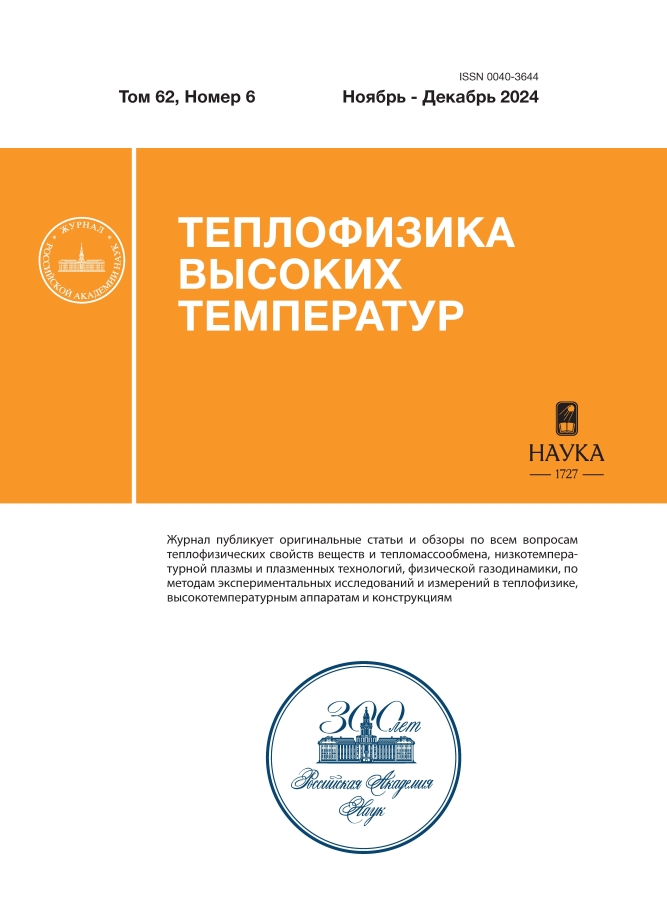Мониторинг очагов возгорания на поверхности Земли
- Autores: Жиляев Д.А.1, Смирнов Б.М.1, Терешонок Д.В.1
-
Afiliações:
- Объединенный институт высоких температур РАН
- Edição: Volume 62, Nº 6 (2024)
- Páginas: 920-928
- Seção: New energy and modern technologies
- URL: https://bioethicsjournal.ru/0040-3644/article/view/683701
- DOI: https://doi.org/10.31857/S0040364424060143
- ID: 683701
Citar
Texto integral
Resumo
Дополнительно к современным методам мониторинга температуры объектов, находящихся на поверхности Земли, предложен метод обнаружения очагов возгорания по повышенной концентрации молекул углекислого газа. В основу данного метода положены спектроскопические измерения. Проанализировано изменение потока излучения молекул углекислого газа на лазерных линиях (в области 10.6 и 9.4 мкм), которые попадают в окно прозрачности атмосферы. Это изменение определяется как увеличением концентрации молекул углекислого газа у поверхности Земли, которые выделяются в результате горения, так и повышенной температурой излучающих молекул. Проанализированы возможности предлагаемого метода.
Texto integral
Sobre autores
Д. Жиляев
Объединенный институт высоких температур РАН
Email: bmsmirnov@gmail.com
Rússia, Москва
Б. Смирнов
Объединенный институт высоких температур РАН
Autor responsável pela correspondência
Email: bmsmirnov@gmail.com
Rússia, Москва
Д. Терешонок
Объединенный институт высоких температур РАН
Email: bmsmirnov@gmail.com
Rússia, Москва
Bibliografia
- Thermography. https://en.wikipedia.org/wiki/Ther-mography#Cameras
- Ring E.F., Ammer K. Infrared Thermal Imaging in Medicine // Physiol. Meas. 2012. V. 33. P. 33.
- Huang Yao, Rongjun Qin, Xiaoyu Chen. Unmanned Aerial Vehicle for Remote Sensing Applications – A Review // Remote Sens. 2019. V. 11. P. 1443.
- Fourier Transform Infrared Spectroscopy. https://en.wikipedia.org/w/index.php?title=Fourier_transform_infrared_spectroscopy
- Goody R.M. Atmospheric Radiation: Theoretical Basis. London: Oxford Univ. Press, 1964. 436 p.
- Goody R.M. Principles of Atmospheric Physics and Chemistry. London: Oxford Univ. Press, 1995. 336 p.
- Hudson R.D., Hudson J.W. The Military Applications of Remote Sensing by Infrared // Proc. IEEE. 1975. V. 63. P. 104.
- Smirnov B.M. Transport of Infrared Atmospheric Radiation. Berlin: de Gruyter, 2020. 250 p.
- Зельдович Я.Б., Райзер Ю.П. Физика ударных волн и высокотемпературные гидродинамические явления. М.: Наука, 1966. 688 с.
- Смирнов Б.М. Инфракрасное излучение в энергетике атмосферы // ТВТ. 2019. Т. 57. № 4. С. 609.
- Смирнов Б.М. Проблемы глобальной энергетики атмосферы // ТВТ. 2021. Т. 59. № 4. С. 589.
- Center for Astrophysics. https://www.cfa.harvard.edu/
- Hitran. https://hitran.iao.ru/
- Smirnov B.M., Zhilyaev D.A. Greenhouse Effect in the Standard Atmosphere // Foundations. 2021. V. 1. P. 184.
- U.S. Standard Atmosphere, 1976. Washington DC: Gov. Printing Office, 1976. 243 p.
- Krainov V.P., Reiss H.R., Smirnov B.M. Radiative Processes in Atomic Physics. N.Y.: Wiley, 1997. 309 p.
- Krainov V.P., Smirnov B.M. Attomic and Molecular Radiative Processes. Switzerland: Springer Nature, 2019. 273 p.
- Собельман И.И. Введение в теорию атомных спектров. М.: Наука, 1977. 320 с.
- Reif F. Statistical and Thermal Physics. Boston: McGrow Hill, 1965. 651 p.
- Barrett R.T. Investigation into Integrated Free-form and Precomputational Approaches for Aerostructural Optimization of Wind Turbine Blades. Master Sci. Thesis. Brigham Young University, 2018. 76 p.
Arquivos suplementares














